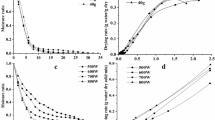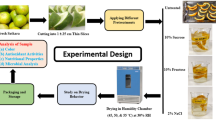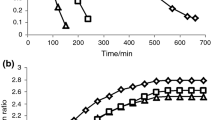Abstract
The drying of pomegranate seeds was investigated at 40 °C, 50 °C and 60 °C with air velocity of 2 m/s. Prior to drying, seeds were osmodehydrated in 55 °Brix sucrose solution for 20 min at 50 °C. The drying kinetics and the effects of osmotic dehydration (OD) and air-drying temperature on antioxidant capacity, total phenolics, colour and texture were determined. Analysis of variance revealed that OD and air-drying temperature have a significant influence on the quality of seeds. Both anthocyanin and total phenolic contents decreased when air-drying temperature increased. The radical diphenylpicril-hydrazyl activity showed the lowest antioxidant activity at 60 °C. Both chromatic parameters (L*, C* and h°) and browning index were affected by drying temperatures, which contributed to the discolouring of seeds. The final product has 22%, 20% and 16% of moisture; 0.630, 0.478 and 0.414 of a w; 151, 141 and 134 mg gallic acid equivalent/100 g fresh matter (FM) of total phenolics; 40, 24, 20 mg/100 g FM of anthocyanins and 46%, 39% and 31% of antioxidant activity, for drying temperatures of 40 °C, 50 °C and 60 °C, respectively. In view of these results, the temperature of 40 °C is recommended as it has the lowest impact on the quality parameters of the seeds. Differential scanning calorimetry data provided complementary information on the mobility changes of water during drying. Glass transition temperature (Tg′) depends on moisture content and as consequence, on drying conditions. In fact, Tg′ of seeds dried at 60 °C (Tg′ = −21 °C) was higher than those dried at 50 °C (Tg′ = −28 °C) or 40 °C (Tg′ = −31 °C) and osmodehydrated seeds (Tg′ = −34 °C). During OD and drying process, the texture of seeds changed. The thickness of seeds shrank by 55% at 60 °C.


Similar content being viewed by others
References
Ahrné, L., Prothon, F., & Funebo, T. (2003). Comparison of drying kinetics and texture effects of two calcium pre-treatment before microwave-assisted dehydration of apple and potato. International Journal of Food Science and technology, 38, 411–420.
AOAC. (1990). Official methods of analysis of the association of official analytical 436 chemists, 15th ed. In K. Helrich (Ed.), Association of Official Analytical Chemists, Inc., 437. Arlington, Virginia, VA.
Arabhosseini, A., Padhye, S., Huisman, W., Boxtel, A., & Müller, J. (2009). Effect of drying on the color of tarragon (Artemisia dracunculus L.) leaves. Food and Bioprocess Technology. doi:10.1007/s11947-009-0305-9 (in press).
Aversa, M., Curcio, S., Calabrò, V., & Iorio, G. (2009). Experimental evaluation of quality parameters during drying of carrot samples. Food and Bioprocess Technology. doi:10.1007/s11947-009-0280-1 (in press).
Bchir, B., Besbes, S., Attia, H., & Blecker, C. (2009). Osmotic dehydration of pomegranate seeds: Mass transfer kinetics and DSC characterization. International Journal of Food Science and Technology, 44, 2208–2217.
Bchir, B., Besbes, S., Attia, H., & Blecker, C. (2010a). Osmotic dehydration of pomegranate seeds (Punica granatum L.): Effect of freezing pre-treatment. Journal of Food Process Engineering. doi:10.1111/j.1745-4530.2010.00591.x (in press).
Bchir, B., Besbes, S., Giet, J., Attia, H., & Blecker C. (2010b). Synthèse des connaissances sur la déshydratation osmotique. Biotechnologie Agronomie Société et Environnement (in press).
Bchir, B., Besbes, S., Karoui, R., Paquot, M., Attia, H., & Blecker, C. (2010c). Osmotic dehydration kinetics of pomegranate seeds using date juice as an immersion solution base. Food and Bioprocess Technology. doi:10.1007/s11947-010-0442-1 (in press).
Biglari, F., Abbas, F., & Easa, A. (2008). Antioxidant activity and phenolic content of various date palm (Phoenix dactelifera) fruits from Iran. Food Chemistry, 107, 1636–1641.
Cemeroglu, B., Velioglu, S., & Isik, S. (1994). Degradation kinetics of anthocyanins in sour cherry juice and concentrate. Journal of Food Science, 59, 1216–1217.
Chenlo, F., Moreira, R., Herrero, F., & Vazquer, G. (2007). Osmotic dehydration of chestnut with sucrose: Mass transfer processes and global kinetics modelling. Journal of Food Engineering, 78, 765–774.
Choi, Y., Lee, S., Chun, J., Lee, H., & Lee, J. (2006). Influence of heat treatment on the antioxidant activities and polyphenolic compounds of Shiitake mushroom. Food Chemistry, 99, 381–387.
Chong, C., Law, C., Cloke, M., Hii, C., & Abdullah, L. (2008). Drying kinetics and product quality of dried chempedak. Journal of Food Engineering, 88, 522–527.
Cisse, M., Dornier, M., Sakho, M., Ndiaye, A., Reynes, M., & Sock, O. (2009). Le bissap (Hibiscus sabdariffa L.): composition et principales utilisations. Fruits, 64(3), 179–193.
Defilippi, G., Whitaker, B., Hess-Pierce, B., & Kader, A. (2006). Development and control of scald on wonderful pomegranates during long-term storage. Postharvest Biology and Technology, 41, 234–243.
Devic, E., Guyot, S., Daudin, J., & Bonazzi, C. (2010) Kinetics of Polyphenol Losses During Soaking and Drying of Cider Apples. Food and Bioprocess Technology, 3, 867–877.
Doymaz, I. (2007). Air-drying characteristics of tomatoes. Journal of Food Engineering, 78, 1291–1297.
El-Aouar, A., Azoubel, P., & Murr, F. (2003). Drying kinetics of fresh and osmotically pre-treated papaya (Carica papaya L.). Journal of Food Engineering, 59, 85–91.
Erbay, Z., & Icier, F. (2009). Optimization of hot air drying of olive leaves using response surface methodology. Journal of Food Engineering, 91, 533–541.
Espiard, E. (2002). Introduction à la transformation industrielle des fruits. TEC and DOC-Lavoisier, pp. 181–182.
Fabiano, A. N., Oliveira, F., & Rodrigues, S. (2008). Use of ultrasoud for dehydration of papayas. Food and Bioprocess Technology, 1, 339–345.
Fadavi, A., Barzegar, M., Azizi, H., & Bayat, M. (2005). Physicochemical composition of ten pomegranate cultivars (Punica granatum L.) grow in Iran. Journal of Food Science Technology, 11, 113–119.
Falade, O., & Onyeoziri, N. (2010). Effects of cultivar and drying method on color, pasting and sensory attributes of instant yam (Dioscorea rotundata) flours. Food and Bioprocess Technology. doi:10.1007/s11947-010-0383-8 (in press).
Fathi, M., Mohebbi, B., & Razavi, S. (2009). Application of image analysis and artificial neural network to predict mass transfer kinetics and color changes of osmotically dehydrated kiwifruit. Food and Bioprocess Technology. doi:10.1007/s11947-009-0222-y (in press).
Fathi, M., Mohebbi, M., & Razavi, S. (2010). Effect of osmotic dehydration and air drying on physicochemical properties of dried kiwifruit and modeling of dehydration process using neutral network and genetic algorithm. Food and Bioprocess Technology. doi:10.1007/s11947-010-0452-z (in press).
Friant, N., Marks, B., & Barkker-Arkema, F. (2004). Drying rate of corn. Transaction of the ASAE, 47, 1605–1610.
Gokhale, S., & Lele, S. (2010). Optimization of convective dehydration of beta vulgaris for color retention. Food and Bioprocess Technology. doi:10.1007/s11947-010-0359-8 (in press).
Harbourne, N., Marete, E., Jacquier, J., & O’Riordan, D. (2009). Effect of drying methods on the phenolic constituents of meadowsweet (Filipendula ulmaria) and willow (Salix alba). LWT-Food Science and Technology, 42, 1468–1473.
Hernandez, F., Melgarejo, P., Tomas-Barberan, F. A., & Artes, F. (1999). Evolution of juice anthocyanins Turing ripening of new selected pomegranate (Punica granatum) clones. European Food Research and Technology, 210, 39–42.
Jackman, R. L., & Smith, J. (1996). Anthocyanins and betalains. Natural food colorants. Blackie Acadenamic and Professional, pp. 244–280.
Jaiswal, V., DerMarderosian, A., & Porter, J. (2010). Anthocyanins and polyphenol oxidase from dried arils of pomegranate (Punica granatum L.). Food Chemistry, 118, 11–16.
Jaya, S., & Das, H. (2009). Glass transition and sticky point temperatures and stability/mobility diagram of fruit powders. Food and Bioprocess Technology, 2, 89–95.
Jeantet, R., Croguennec, T., Schuch, P., & Brulé, G. (2006). Science des aliments. TEC and DOC-Lavoisier, pp. 121–161.
Jukunen-Tiitto, R. (1985). Phenolic constituents in the leaves of northern willows: methods for the analysis of certain phenolics. Journal of Agricultural and Food Chemistry, 33, 213–217.
Kang, K., Kim, H., Pyo, J., & Yokozawa, T. (2006). Increase in free radical scavenging activity of ginseng by heat-processing. Biological and Pharmaceutical Bulletin, 29, 750–754.
Kingsly, A., & Singh, D. (2007). Drying kinetics of pomegranate arils. Journal of Food Engineering, 79, 741–744.
Kirca, A., Ozkan, M., & Cemerglu, B. (2007). Effects of temperature, solid content and pH on the stability of black carrot anthocyanins. Food Chemistry, 101, 212–218.
Krokida, M. K., Oreopoulou, V., Maroulis, Z. B., & Marinoskouris, D. (2001). Effect of osmotic dehydration pre-treatment on quality of French fries. Journal of Food Engineering, 49, 339–345.
Kuljarachanan, T., Devahastin, S., & Chiewchan, N. (2009). Avolution of antioxidant compound in lime residues during drying. Food Chemistry, 113, 944–949.
Kulkarni, P., & Aradhya, S. (2005). Chemical changes and antioxidant activity in pomegranate arils during fruit development. Food Chemistry, 93, 319–324.
Lenart, A. (1996). Osmo-convective drying of fruits and vegetables: Technology and application. Drying Technology, 14, 391–413.
Lewicki, P. (2006). Design of hot air drying for better foods. Food Science and Technology, 17, 153–163.
Madamba, P., Driscoll, R., & Buckle, K. (1996). The thin-layer drying characteristics of garlic slices. Journal of Food Engineering, 29, 75–97.
Madrigal-Carballo, S., Rodriguez, G., Krueger, C., Dreher, M., & Reed, J. (2009). Pomegranate (Punica granatum) supplements: Authenticity, antioxidant and polyphenol composition. Journal of Functional Food, 1, 324–329.
Mandala, I., Anagnostaras, E., & Oikonomou, C. (2005). Influence of osmotic dehydration conditions on apple air-drying kinetics and their quality characteristics. Journal of Food Engineering, 69, 307–316.
Marquez, C., & De-Michelis, A. (2009). Comparison of drying kinetics for small fruits with and without particle shrinkage considerations. Food and Bioprocess Technology. doi:10.1007/s11947-009-0218-7 (in press).
Maskan, M. (2001). Kinetics of colour change of kiwifruits during hot air and microwave drying. Journal of Food Engineering, 48, 169–175.
Miranda, M., Maureira, H., Rodriguez, K., & Vega-Galvez, A. (2009). Influence of temperature on the drying kinetics, physicochemical properties, and antioxidant capacity of Aloe Vera (Aloe Barbadensis Miller) gel. Journal of Food Engineering, 91, 297–304.
Mujumdar, A., & Law, C. (2010). Drying technology: Trends and Applications in Postharvest Processing. Food and Bioprocess Technology, 3, 843–852.
Nicoli, M., Anese, M., & Parpinel, M. (1999). Influence of processing on the antioxidant properties of fruit and vegetables. Trends in Food Science and Technology, 10, 94–100.
Park, J., Bin, A., & Brod, F. (2002). Drying of pear d’Anjou with and without osmotic dehydration. Journal of Food Engineering, 56, 97–103.
Pereira, N., Antonia, M., & Ahrne, L. (2007). Effect of microwave power air velocity and temperature on final drying of osmotically dehydrated bananas. Journal of Food Engineering, 81, 79–87.
Pinho, R., Guiné, F., Henrriques, F., & Barroca, M. (2009). Mass transfer coefficients for the drying of pumpkin (Cucurbita moschata) and dried product quality. Food and Bioprocess Technology. doi:10.1007/s11947-009-0275-y (in press).
Pokharkar, S. M., Prasad, S., & Das, H. (1997). A model for osmotic concentration of banana slices. Journal of Food Science and Technology, 34, 230–232.
Ponting, J. D. (1973). Osmotic dehydration of fruits. Resents modifications and applications. Process Biochemistry, 8, 18–20.
Rada-Mendoza, M., Olano, A., & Villamiel, M. (2002). Determination of hydroxymethylfurfural in commercial jams and in fruit-based infant foods. Food Chemistry, 79, 513–516.
Raoult-Wack, A. L., Guilbert, S., Le Maguer, M., & Rios, G. (1991). Simultaneous water and solute transport in shrinking media-part 1: application to dewatering and impregnation soaking process analysis (osmotic dehydration). Drying Technnol, 9(3), 589–612.
Raynal, J., Moutounet, M., & Souquet, J. M. (1989). Intervention of phenolic compound in plum technology. Changes during drying. Journal of Agricultural and Food Chemistry, 37, 1046–1050.
Robert, C., Soliva, F., Martinez, P., Sebastian, M., & Martin, O. (2002). Kinetics of polyphenol oxidase activity inhibition of avocado preserved by combined methods. Journal of Food Engineering, 55, 131–137.
Romano, R., Baranyai, L., Gottschalk, K., & Zude, M. (2008). An approach for monitoring the moisture content changes of drying banana slices with laser light backscattering imaging. Food and Bioprocess Technology, 4, 410–414.
Roos, Y. (1995). Characterisation of food polymers using state diagrams. Journal of Food Engineering, 24, 339–360.
Rosenblat, M., Hayek, T., & Aviram, M. (2006). Anti-oxidative effects of pomegranate juice (PJ) consumption by diabetic patients on serum and macrophages. Atherosclerosis, 187, 363–371.
Ruiz-Lopez, I., Castillo-Zamudio, R., Salgado-Cervantes, M. A., Rodriguez-Jimenes, G. C., & Garcia-Alvarado, M. A. (2010). Mass transfer modeling during osmotic dehydration of hexahedral pineapple silices in limited volume solutions. Food and Bioprocess Technology, 3, 427–433.
Sá, M. M., Figueiredo, A. M., & Sereno, A. M. (1999). Glass transitions and state diagrams for fresh and processed apple. Thermochimica Act, 329, 31–38.
Saxena, A., Maity, T., Raju, P., & Bawa, A. (2010). Degradation kinetics of colour and total carotenoids in jackfruit (Artocarpus heterophyllus) bulb slices during hot air drying. Food and Bioprocess Technology. doi:10.1007/s11947-010-0409-2 (in press).
Sharma, G., Prasad, S., & Chahar, V. (2003). Moisture transport in garlic cloves undergoing microwave-convective drying. Food and Bioproducts Processing, 87, 11–16.
Shi, J., Pan, Z., McHugh, T., Wood, D., Hirschberg, E., & Olson, D. (2008). Drying and quality characteristics of fresh and sugar-infused blueberries dried with infrared radiation heating. LWT-Food Science and Technology, 41, 1962–1972.
Singh, H., & Sodhi, N. (2000). Dehydration kinetics of onions. Journal of Food Science and Technology, 37, 520–522.
Storey, T. (2007). La grenade, le fruit medicament, Magazine NEXUS. Santé, 51, 46–54.
Uribe, E., Vega-Gálvez, A., Scala, K., Oyanadel, R., Torrico, J., & Miranda, M. (2009). Characteristics of convective drying of pepino fruit (Solanum muricatumAit.): application of weibull distribution. Food and Bioprocess Technology. doi:10.1007/s11947-009-0230-y (in press).
Uribe, E., Miranda, M., Vega-Galvez, A., Quispe, I., Claveria, R., & Di Scala, K. (2010). Mass transfer modelling during osmotic dehydration of jumbo squid (dosidicus gigas): influence of temperature on diffusion coefficients and kinetic parameters. Food and Bioprocess Technology. doi:10.1007/s11947-010-0336-2 (in press).
Vega-Galvez, A., Di Scala, K., Rodriguez, K., Lemus-Mondaca, R., Miranda, M., Lopez, J., et al. (2009). Effect of air-drying temperature on physico-chemical properties, antioxidant capacity, colour and total phenolic content of red pepper (Capsicum annuum, L. var. Hungarian). Food Chemistry, 117, 647–653.
Vinas, P., Campillo, N., Hernandez-Cordoba, M., & Candela, M. E. (1992). Simulation liquid chromatographic análisis of 5-(hydroxymethyl)-2-furaldehyde and metil anthranilate in honey. Food Chemistry, 44, 67–72.
Yang, R. Y., Tsou, S. C. S., Lee, T. C., Chang, L. C., Kuo, G., & Lai, P. Y. (2006). Moringa, a novel plant rich in antioxidants, bioavailable iron, and nutrients. In C. T. Ho (Ed.), Challenges in chemistry and biology of herbs (pp. 224–239). Washington, D.C.: American Chemical Society.
Acknowledgment
The authors (B.B) acknowledge the financial support of Gembloux Agro-Bio Tech, University of Liege (Belgium) and National Engineering School of Sfax (Tunisia).
Author information
Authors and Affiliations
Corresponding author
Rights and permissions
About this article
Cite this article
Bchir, B., Besbes, S., Karoui, R. et al. Effect of Air-Drying Conditions on Physico-chemical Properties of Osmotically Pre-treated Pomegranate Seeds. Food Bioprocess Technol 5, 1840–1852 (2012). https://doi.org/10.1007/s11947-010-0469-3
Received:
Accepted:
Published:
Issue Date:
DOI: https://doi.org/10.1007/s11947-010-0469-3




